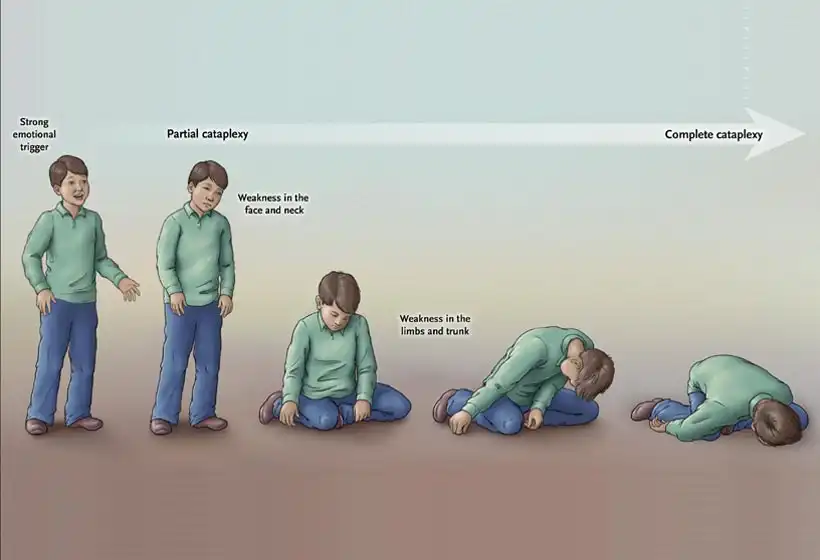Narcolepsy & Cataplexy: Sleep Naturalism to Understand Body’s Hidden Cues

When your body suddenly collapses in laughter or you find yourself falling asleep mid-conversation, your body may be signaling something deeper. Ever found yourself suddenly dozing off to sleep? Or maybe you’ve laughed so hard that your knees buckled beneath you?
These may seem like benign moments, but they could be signs of a complex neurological disorder that affects the very rhythm of your life: narcolepsy and cataplexy.
Our guide will help you understand your body’s cues through the lens of sleep naturalism. We have narcolepsy explained to help tune in to your body’s subtle yet powerful signals.
Narcolepsy Explained: Basics and Beyond
To start, let’s get narcolepsy explained. Narcolepsy is a chronic neurological disorder that affects the brain’s ability to control sleep-wake cycles.
Individuals with narcolepsy often experience excessive daytime sleepiness, uncontrollable sudden sleep attacks, and disruptions in nighttime sleep. This disorder is often misunderstood and underdiagnosed, but it’s more common than you might think.
The condition is often paired with Cataplexy, which leads many to search for clarity on…
What Is Cataplexy?

It’s a sudden, brief loss of voluntary muscle tone triggered by strong emotions such as laughter, excitement, or fear. It is one of the hallmark symptoms that helps differentiate narcolepsy type 1 vs type 2.
- Type 1 involves cataplexy and low levels of hypocretin in the brain.
- Type 2 does not involve cataplexy and tends to have milder symptoms.
Sleep specialists often get questions about narcolepsy vs hypersomnia. While both involve excessive sleepiness, hypersomnia is marked by prolonged sleep episodes and difficulty waking, rather than uncontrollable sudden sleep attacks or sleep paralysis.
As you gradually understand what cataplexy is, in a gentle, holistic way, you’ll learn to awaken your natural sleep rhythm through a naturalistic lens. All the while, dealing with complex neurological disorders to improve your sleep quality.
Cataplexy Causes & Symptoms
Let’s now detail about cataplexy causes and symptoms.
What Triggers Sudden Muscle Weakness?
Cataplexy is typically triggered by strong emotions, which cause a sudden loss of muscle tone—while the person remains fully conscious. It’s closely associated with narcolepsy type 1, and is believed to result from a deficiency of hypocretin (orexin), a brain chemical that helps regulate wakefulness and muscle tone.
Primary Causes & Triggers of Cataplexy
- Laughter – One of the most common triggers
- Excitement or Joy – High emotional arousal can bring on an episode
- Surprise or Startle – Unexpected events or loud noises
- Anger or Frustration – Intense negative emotions can also trigger weakness
- Fear – Especially sudden or intense fear
- Embarrassment – Social anxiety or self-consciousness
- Stress or Anxiety – Emotional overload may initiate episodes
- Sudden emotional reactions – Like crying, anticipation, or even pride
- Sleep deprivation – Increases vulnerability to cataplexy episodes
- Alcohol or certain medications – May exacerbate muscle relaxation or REM intrusions
Biological Cause Behind Cataplexy
- Hypocretin Deficiency: The root biological cause of cataplexy in most patients with narcolepsy type 1 is a dramatic loss (up to 90%) of hypocretin-producing neurons in the hypothalamus.
- This leads to REM sleep features (like muscle atonia) intruding into wakefulness—causing cataplexy.
Symptoms
- Muscle Weakness – Episodes are often described as potential muscle weakness triggered by emotions (cataplexy), lasting from a few seconds to several minutes.
- Slumping and Buckling – Though consciousness is preserved, the body can slump, knees buckle, or even collapse entirely.
- Paralysis and Hallucinating – Other symptoms include hallucinations (both hypnagogic and hypnopompic), sleep paralysis, and disrupted night-time sleep.
From a narcolepsy sleep naturalism perspective, these are your body’s warning signals — calling for balance, regulation, and better sleep hygiene.
Narcolepsy vs Hypersomnia: What’s the Difference?

Many people confuse narcolepsy vs hypersomnia, as both involve excessive sleepiness.
The key difference?
In narcolepsy, sleepiness is sudden and often accompanied by cataplexy, sleep paralysis, and hallucinations. In hypersomnia, sleepiness is prolonged but without the abrupt sleep attacks or REM-related disruptions.
Table: Hypersomnia vs. Narcolepsy
| Feature | Narcolepsy | Hypersomnia |
|---|---|---|
| Definition | A neurological sleep disorder causing uncontrollable sudden sleep attacks and REM-related symptoms. | A condition marked by excessive sleep duration and daytime sleepiness without sudden onset. |
| Daytime Sleepiness | Severe and sudden; may fall asleep abruptly in any situation. | Persistent, gradual excessive daytime sleepiness despite long sleep hours. |
| Cataplexy | Present in narcolepsy type 1; involves muscle weakness triggered by emotions (cataplexy). | Absent. Cataplexy is not a feature of hypersomnia. |
| Sleep Paralysis | Common; temporary inability to move or speak when falling asleep or waking. | Rare or absent. |
| Hallucinations | Vivid dream-like experiences (hallucinations) upon sleep onset or awakening. | Less common. |
| REM Sleep Abnormalities | REM sleep may occur very quickly after sleep onset. | Normal REM onset, but prolonged non-REM phases. |
| Sleep Duration | Total sleep time may be normal or slightly increased. | Sleep can extend beyond 10 hours/day without feeling refreshed. |
| Onset Age | Typically starts in adolescence or early adulthood. | Often begins in late adolescence or early adulthood. |
| Core Cause | Loss of hypocretin-producing neurons in the brain. | Often idiopathic; may be due to brain injury, genetics, or unknown causes. |
| Treatment Approach | Stimulants, scheduled naps, lifestyle changes, and sometimes antidepressants. | Stimulants, behavioral therapy, good sleep hygiene. |
Understanding this distinction is crucial to seeking proper diagnosis and lifestyle support.
Sleep Naturalism & Recognizing Hidden Signals – Narcolepsy
Narcolepsy in sleep naturalism encourages recognizing and honoring your body’s signals using a holistic approach. Rather than only treating symptoms medically, it emphasizes aligning lifestyle, sleep hygiene, diet, and rest routines to support natural circadian rhythms.
Some subtle symptoms to watch for:
- Persistent excessive daytime sleepiness
- Hypnagogic or hypnopompic hallucinations
- Sleep paralysis upon waking or falling asleep
- Delayed response to emotions, leading to cataplexy causes symptoms
Naturalistic sleep methods such as consistent sleep schedules, meditation, and limiting screen time can significantly improve quality of life for those living with cataplexy.
Pro Tip – Looking to make sleep more manageable? A mattress built for pressure relief and motion control might just be the starting point for better nights and more energized days.
Living with Cataplexy & Holistic Sleep Tips
It often means adapting your lifestyle to honor the body’s new rhythm.
From a sleep naturalism standpoint, gentle movement practices like yin yoga and daily exposure to natural sunlight can help reset your internal clock. Incorporate short, scheduled naps, practice stress management, and build a regular sleep routine.
But lifestyle changes aren’t always enough.
If temperature regulation is a concern, a mattress with cooling features can significantly reduce sleep disruptions.
Consider investing in:
- Best mattress overall: DreamCloud Premier Mattress
- Best for stomach sleepers: Helix Dawn Mattress
- Best mattress for allergies: Saatva Classic Mattress
- Best mattress for back pain: Puffy Cloud Mattress
- Best for edge support: Avocado Green Mattress
Can Your Mattress Help With Narcolepsy Symptoms?
Yes—your mattress matters more than you might think.
For individuals with narcolepsy, a medium-firm mattress that offers good support and pressure relief is generally recommended. Materials like memory foam, latex, or hybrid mattresses can conform to the body and ease tension—especially when paired with a well-balanced lifestyle.
If you’re looking to improve sleep quality while managing narcolepsy or cataplexy, consider these top picks:
Table: 5 Best Mattresses for Narcolepsy or Cataplexy
| Mattress Name | Type | Price for Queen Mattresses | Firmness | Key Features | Warranty/Trial | Ideal For |
|---|---|---|---|---|---|---|
| DreamCloud Premier Mattress
(4.08/5.00) |
Hybrid | Approx $1500 | Medium-Firm | Known for its pressure relief, motion isolation, plush yet supportive feel | Lifetime Warranty / 365 Nights |
Best overall pick for individuals with sudden sleep attacks and sleep paralysis |
| Helix Dawn Mattress
(4.08/5.00) |
Hybrid | Approx. $1200 | Firm | Strong lumbar support, great for spinal alignment, responsive foam | 10-Year Warranty / 100 Nights |
Stomach sleepers, those prone to muscle fatigue from cataplexy episodes |
| Saatva Classic Mattress
(4.17/5.00) |
Innerspring | Approx. $2000 | Customizable (Plush, Luxury Firm, Firm) | Organic, hypoallergenic, zoned lumbar support | Lifetime Warranty / 365 Nights |
Great for allergy-sensitive sleepers and those seeking sleep naturalism |
| Puffy Cloud Mattress
(3.83/5.00) |
Memory Foam | Approx. $2000 | Medium | Cloud-like feel, low motion transfer, deep pressure relief | Lifetime Warranty / 101 Nights |
Ideal for sleepers with back pain or REM-sleep disruptions |
| Avocado Green Mattress
(4.38/5.00) |
Latex Hybrid | Approx. $2000 | Firm | Natural latex, edge-to-edge support, temperature regulating | 25-Year Warranty / 365 Nights |
Eco-conscious buyers needing edge support and cooling for hot sleepers with narcolepsy |
Natural Remedies for Narcolepsy

Gentler Approach
While medications exist, natural remedies for narcolepsy can provide real relief and alignment with sleep naturalism.
These include:
- Melatonin supplements
- Magnesium-rich diets
- Limiting sugar and caffeine
- Daytime naps at structured intervals
- Yin yoga, mindfulness, and controlled breathing
Mindfulness, meditation, and breathing exercises can also support the parasympathetic nervous system and help reduce stress-induced triggers for cataplexy causes symptoms.
Combined with an appropriate mattress setup, this naturalistic approach offers a non-invasive way to reduce symptom intensity and promote deeper, more restorative sleep.
Pro Tip: Creating a wind-down routine and investing in a supportive mattress can go a long way in reducing anxiety around nighttime symptoms like sleep paralysis and hallucinations.
Smart Take
Trusting Your Body’s Natural Rhythms
Understanding the body’s hidden signals through the lens of narcolepsy sleep naturalism empowers you to take proactive steps. Whether you’re managing living with cataplexy or coping with hallucinations and sleep paralysis, your journey begins with awareness.
Healing is never one-size-fits-all.
Narcolepsy sleep naturalism isn’t just about sleep—it’s about living in harmony with your body’s unique rhythm.
But when you begin with rest, support your sleep naturally, and listen to what your body is trying to say, you’re already on the path to recovery.

